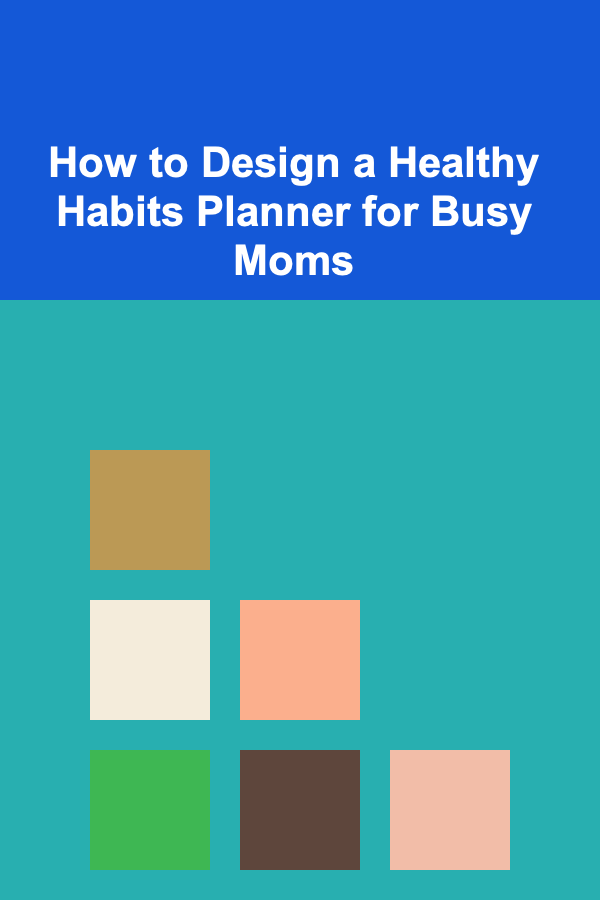
How to Design a Healthy Habits Planner for Busy Moms
ebook include PDF & Audio bundle (Micro Guide)
$12.99$7.99
Limited Time Offer! Order within the next:

As a busy mom, juggling daily responsibilities and self-care can feel like an overwhelming challenge. With family commitments, work, chores, and personal tasks, the idea of establishing and maintaining healthy habits often falls to the bottom of the priority list. However, with the right planner in place, moms can create an actionable plan to incorporate healthy habits into their busy schedules and ultimately improve their well-being.
This article explores how to design a healthy habits planner that works for busy moms. We will delve into strategies that will help moms prioritize self-care, set realistic goals, track progress, and maintain motivation---all within the framework of a busy lifestyle.
Why a Healthy Habits Planner?
Moms are often at the center of their families' needs, making it easy to put their own health and wellness on the back burner. A dedicated healthy habits planner serves as a tool that not only helps prioritize health and wellness but also empowers moms to be more intentional with their time. With the right structure, a planner can:
- Increase productivity by organizing daily tasks and habits
- Help build consistency with the tracking of habits
- Reduce stress by breaking down big tasks into manageable goals
- Promote mental and physical well-being through structured self-care practices
While every mom's needs and schedule vary, a healthy habits planner can be customized to fit individual goals and lifestyles.
Step 1: Understand Your Needs and Priorities
Before designing a healthy habits planner, it's important to first reflect on the habits and routines you want to develop. Healthy habits vary from person to person, and for busy moms, it's important to take a holistic approach that encompasses not only physical health but also emotional and mental well-being.
Key Areas to Focus On:
- Physical Health: Exercise, nutrition, hydration, sleep
- Mental Health: Stress management, mindfulness, hobbies, gratitude
- Emotional Health: Family connections, personal relationships, self-compassion
- Spiritual Health (optional): Reflection, meditation, prayer, or other practices that promote inner peace
Once you have identified the key areas that matter most to you, you can tailor your planner to focus on what's essential for your well-being.
Step 2: Define Clear, Realistic Goals
Having a clear understanding of your health priorities will make it easier to set specific, realistic goals. Setting too many ambitious goals in one go can lead to burnout, so it's better to start with small, achievable targets. The key is to break down big goals into smaller steps that can be integrated into your routine.
Examples of Goal Setting:
- Physical Health: Aim for 30 minutes of exercise three times a week. Start with a walk or yoga session before progressing to more intense activities.
- Nutrition: Incorporate one healthy meal or snack each day. For instance, replace a sugary snack with a piece of fruit or prepare a vegetable-based dinner twice a week.
- Mental Health: Dedicate 5--10 minutes daily to mindfulness or journaling to reduce stress.
- Emotional Health: Set aside a weekly date night with your partner or spend 10 minutes of undistracted time with each child.
Ensure these goals are Specific, Measurable, Achievable, Relevant, and Time-bound (SMART). For example, instead of just saying "exercise more," aim to "complete 30 minutes of exercise on Monday, Wednesday, and Friday."
Step 3: Design a Planner that Fits Your Lifestyle
A healthy habits planner should reflect your personal schedule and responsibilities. It needs to be practical, easy to follow, and flexible. A one-size-fits-all approach may not work, so take the time to design a planner that caters to your unique needs.
Here's how to customize your planner:
Format and Medium:
- Paper Planner: For those who love the tactile experience, a paper planner might be the best option. Choose a weekly or monthly planner that allows for ample space for both short-term and long-term planning.
- Digital Planner: If you're tech-savvy or often on the go, a digital planner may be more convenient. Apps like Google Calendar, Notion, or Trello allow for easy tracking and reminders. You can access your planner on multiple devices, making it flexible for a busy schedule.
- Bullet Journal: A hybrid between a paper planner and creative outlet, bullet journals allow for customization through drawings, colors, and specific layouts.
Create Sections for Key Habits:
Your planner should have distinct sections for each of the areas you want to focus on. For example:
- Daily Habit Tracker: A section to track the habits you want to perform every day, such as drinking water, exercising, or meditating.
- Weekly Goal Breakdown: Set specific goals for each week. Use space to list your meal plan, exercise schedule, and stress-reduction practices.
- Monthly Reflection: A section at the end of each month where you reflect on your progress, acknowledge challenges, and adjust goals as necessary.
- Self-Care Reminders: Include a dedicated space for reminders of self-care activities---such as reading, taking a bath, or spending time in nature---that promote mental well-being.
Use Visuals to Stay Motivated:
Incorporate motivational quotes, affirmations, or images that inspire you. Many people find visual reminders helpful in staying motivated. Whether it's a picture of your family, a mantra to keep you going, or a milestone you want to reach, having visuals in your planner can keep you on track.
Step 4: Include Simple, Manageable Daily Actions
The key to creating lasting healthy habits is consistency. Busy moms don't have time for elaborate routines, so the actions you choose should be simple yet effective. Instead of aiming for perfection, focus on creating achievable daily actions that fit into your lifestyle.
Here are some ideas for daily actions:
- Exercise: A 15-minute workout or a 30-minute walk. Set a time that works within your day, whether it's during lunch or in the early morning before the kids wake up.
- Nutrition: Drink at least 8 cups of water a day. Include one vegetable in every meal or prepare a healthy snack each morning.
- Mindfulness: Spend 5 minutes meditating or journaling every morning. Or practice deep breathing for 2 minutes before bed to wind down.
- Sleep: Set a bedtime that allows for at least 7-8 hours of sleep. Use your planner to ensure you're going to bed at the same time every night.
To avoid overwhelming yourself, start with one or two habits per week and gradually add more as you become comfortable. Remember, the aim is to develop sustainable habits rather than creating a rigid, time-consuming routine.
Step 5: Build in Accountability and Support
Accountability is a powerful motivator. As a mom, you are not alone in your journey to wellness. Having a support system can help you stay consistent and encouraged. Here are a few ways to integrate accountability into your planner:
- Track Progress: Use your planner to track each habit's completion every day. Checking off a habit or coloring in a progress bar can give you a sense of accomplishment.
- Involve Family: Ask your spouse or children to hold you accountable. For example, ask your partner to join you in a short workout or involve your children in preparing healthy meals.
- Join a Community: Whether it's a workout group or a mom's wellness group, having a community of like-minded individuals can provide motivation and support. Include a space in your planner for reflecting on your experiences with your support group.
Step 6: Make Adjustments as Needed
A healthy habits planner should be flexible enough to accommodate life's unpredictability. If something isn't working, don't hesitate to make adjustments. For example, if a particular exercise isn't possible, replace it with one that's more convenient or enjoyable.
Review and Adapt:
- Weekly Reviews: At the end of each week, take a few minutes to review your progress. Celebrate the small wins and identify any challenges that may need addressing.
- Monthly Reflection: At the end of each month, reflect on your habits and overall well-being. If necessary, tweak your goals or try new habits to ensure they align with your current needs and lifestyle.
Step 7: Prioritize Self-Care
Amidst the busyness of life, it's easy for self-care to get pushed aside. However, self-care is an essential part of maintaining physical, emotional, and mental health. Your planner should include self-care as a priority, not an afterthought.
Some ideas for self-care include:
- Taking a 10-minute break to rest and recharge during the day
- Enjoying a quiet cup of tea or coffee in the morning
- Scheduling a weekly self-care activity, such as a bath, a book, or time for a hobby
- Practicing gratitude or affirmations at the start or end of your day
A healthy habits planner is a powerful tool for self-care, helping you prioritize your well-being without feeling overwhelmed.
Conclusion
Designing a healthy habits planner for busy moms is about creating a structured yet flexible system that promotes well-being, consistency, and self-care. By understanding your needs, setting realistic goals, and integrating manageable actions into your daily routine, you can gradually build habits that enhance your physical, mental, and emotional health. The key is consistency and adaptability---making your planner a reflection of your unique lifestyle, rather than a rigid set of rules.
Remember that being a mom is a demanding role, and taking care of yourself is not just a luxury---it's a necessity. With a healthy habits planner in place, you can create balance and thrive in both your role as a mom and as an individual. Start small, stay consistent, and allow yourself to grow at your own pace. Your health and well-being are worth the effort.
Reading More From Our Other Websites
- [Reading Habit Tip 101] From Skipping to Savoring: Transform Your Busy Life into a Reading Lifestyle
- [Personal Care Tips 101] How to Choose the Right Deodorant for Different Weather Conditions
- [Soap Making Tip 101] From Kitchen to Craft Room: Essential Tools and Tips for Aspiring Soap Makers
- [Home Party Planning 101] How to Choose a Fun Home Party Theme for Adults
- [Biking 101] Top 5 Bike Stands for Easy Repairs and Maintenance
- [Home Budget 101] How to Budget for Home Improvement Projects Without Overspending
- [Home Budget 101] How to Save Money on Utilities and Lower Your Monthly Bills
- [Organization Tip 101] Troubleshooting Common Issues with Whole-House Fans
- [Personal Financial Planning 101] How to Build Financial Security with Multiple Streams of Income
- [Home Holiday Decoration 101] How to Add a Touch of Whimsy to Your Holiday Home with Fun Decor

How to Create Elegant Lighting in Your Home for Entertaining
Read More
Overcoming Common Job Search Challenges: Strategies That Work
Read More
How to Repair and Restore Antique License Plates
Read More
How to Use Power BI for Business Intelligence Reporting
Read More
10 Tips for Choosing the Right Electrician for Your Project
Read More
10 Tips for Managing Executive Reputation as a PR Professional
Read MoreOther Products

How to Create Elegant Lighting in Your Home for Entertaining
Read More
Overcoming Common Job Search Challenges: Strategies That Work
Read More
How to Repair and Restore Antique License Plates
Read More
How to Use Power BI for Business Intelligence Reporting
Read More
10 Tips for Choosing the Right Electrician for Your Project
Read More